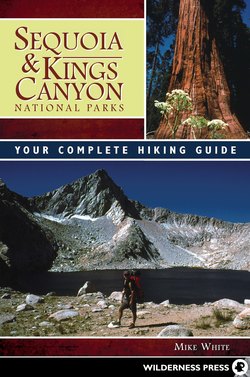Читать книгу Sequoia and Kings Canyon National Parks - Mike White - Страница 17
На сайте Литреса книга снята с продажи.
ОглавлениеSOUTH FORK KAWEAH RIVER TRAILHEAD
TRIP 2
Ladybug Camp and Cedar Creek
DH or BP
DISTANCE: 3.5 miles, out-and-back to Ladybug Camp
5.6 miles, out-and-back to Cedar Creek
ELEVATION: 3,620′/4,300′, +960′/-180′/±2,280′ to Ladybug Camp
3,620′/5,800′, +1,880′/-325′/±4,410′ to Cedar Creek
SEASON: All year to Ladybug Camp
March to December to Cedar Creek
USE: Light
MAPS: Dennison Peak and Moses Mountain
TRAIL LOG
1.75 Ladybug Camp
2.75 Cedar Creek
INTRODUCTION: The Ladybug Trail offers a fine opportunity for off-season hiking. During March and April, blooming wildflowers complement the green grasslands, both of which are replenished by the winter rains. Also in spring, deciduous trees of the oak woodland leaf out, returning signs of life to their previously bare branches. South Fork Kaweah River is at full force at this time, cascading and churning through the foothills, before ultimately realizing a much tamer fate in the San Joaquin Valley. Fall adds a touch of crispness to the air and a splash of autumn color to the deciduous forest. Toss in the chance for an up-close experience with the giant sequoias at Cedar Creek, and you have the makings for a splendid outing. As with all foothills trips, watch for ticks, rattlesnakes, and poison oak.
DIRECTIONS TO TRAILHEAD: Follow State Highway 198 to Three Rivers and turn east onto South Fork Road, approximately 7 miles southwest of the Ash Mountain Entrance to Sequoia National Park. Follow South Fork Road 9 miles to the end of the pavement, and continue another 3 miles on narrow, dirt road to free South Fork Campground (vault toilets). Proceed through the campground to a small, oak-shaded hikers’ parking area.
DESCRIPTION: From the parking area, head east upstream on a wide trail to the wood bridge spanning the South Fork Kaweah River and cross to the far side. Begin a moderate ascent through oak woodland and scattered boulders high above the river. Just before crossing the usually dry streambed of Pigeon Creek, you may notice the remnants of an old, now abandoned path that once led hikers steeply uphill to Homers Nose. Beyond Pigeon Creek, the trail ultimately emerges out of the forest to a fine view of the river below and also ahead to Putnam Canyon and its cascading creek. A gentle climb then leads back into the trees and on to a log-and-boulder crossing of Squaw Creek 0.9 mile from the trailhead.
Hockett Meadow Ranger Station
A moderate, 0.75-mile climb takes you away from the creek and back into the main canyon. Continue upstream, alternating between the filtered shade of oak woodland and the sun-drenched sky above patches of chaparral. A gentle descent heralds your arrival at the flat of Ladybug Camp alongside the swirling South Fork, where oaks, incense cedars, and a few ponderosa pines shade pleasant campsites. The area received its name from a wintering population of ladybugs.
Beyond Ladybug Camp, the trail continues upstream a short distance to an unofficial junction with a use trail heading straight ahead to an open area of rock slabs on a narrow bench. From this spot, directly above the river and across from the confluence of Garfield Creek, a breathtaking view unfolds when the tumbling river is flush with snowmelt, churning and plunging down the canyon.
THE BRIDGE THAT ISN’T
You may notice some reinforcing steel protruding out of rock on either side of the river just above the confluence with Garfield Creek, remnants of an old bridge that once spanned the South Fork. A trail that formerly led from the bridge up a ridge to connect with the Garfield-Hockett Trail was abandoned after the bridge collapsed from heavy snows in 1969.
From the Ladybug Camp junction, the main trail bends away from the river and climbs moderately up a grassy hillside dotted with oaks and cedars. Through gaps in the trees you have fine views of Homers Nose 4,000 feet above, a granite dome dubiously named by a surveyor for its resemblance to the nose of his guide, John Homer. Keen eyes will notice a smattering of giant sequoias across the canyon, their characteristic rounded tops thrusting skyward. These specimens of Garfield Grove represent the lowest-elevation sequoias in the Sierra. The views eventually disappear in a thickening forest of oaks and cedars on the approach to Cedar Creek. Along the banks, a number of sequoias tower over their neighboring conifers, with several younger sequoias sprinkled throughout the drainage.
A variety of options once existed for travel further into the Sequoia frontcountry beyond where maintained trail dead-ends at Cedar Creek. Hikers can still follow remnants of the old trail beyond the creek to a Y-junction, where a metal sign with punched-out letters gives directions to Cahoon Meadow and South Fork. Since the 1970s, neither trail has been maintained, and both are currently overgrown with brush and blocked by deadfalls and washouts. The South Fork branch descends to a grove of sequoias in the South Fork Canyon and an old campsite at Whiskey Log Camp, about 2 miles from Cedar Creek. However, the hiking is difficult and tedious; attempt it only if you have experience bushwhacking and hiking off-trail.
Wilderness permits are required for overnight stays. Campfires are permitted.
